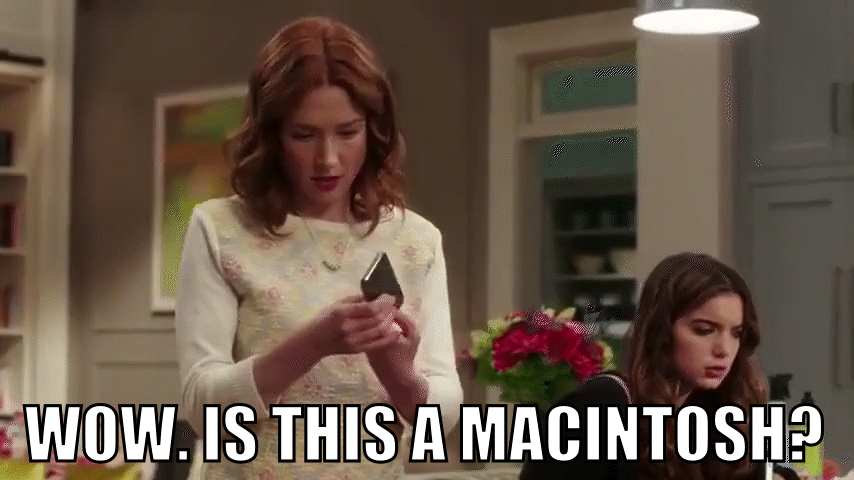
Macintosh Pocket
Designing a fake vintage product.
// CONCEPTION
This idea started brewing years ago when watching the show Kimmy Schmidt. Kimmy had been in a shelter, locked away from the world for a long time and now that she's out she's rediscovering the world. She's handed an iPhone and after seeing the Apple logo on the back exclaims "WOW! Is this a Macintosh!?!".

Kimmy Schmidt. "Wow. Is this a Macintosh?"
// INSPIRATION
I started thinking in my head about a Macintosh Phone. No one in the 80's or 90's could have dreamed up an Apple product like the iPhone of today. But what if Apple had tried to make a pocket Macintosh? It came down to wanting to take the Macintosh Classic and slim it down into a device similar to the Game Boy.
Oddly enough if never felt right to turn this into a Macintosh "Phone". In the late 80s it wouldn't have made sense to make a computer that was primarily a phone. For this reason you might notice a lack of earpiece and microphone.
I debated on giving it a floppy drive slot but ended just focusing on classic Mac connections. I spent a lot of time studying vintage Mac styles and the Snow White design language Apple used in the late 80s. I drew most of my inspiration from the models I knew best, which were the ones my family owned, the Macintosh Classic, the Performa and Quadra. I then took those attributes and used the Game Boy Pocket as my layout guide and inspiration.
// TRACKING ISSUES
Deciding how to implement controlling the curser is probably the aspect I spent the most consideration on. Touch screen wouldn't fit, as well as I knew a track pad would be a little too after the time period I was shooting for. I was hesitant to put in a trackball because I didn't want it to have Blackberry vibes. In the end I decided a trackball was best and I drew inspiration from the trackball in the early PowerBooks, even down to the click button curving around the ball. I demoed putting the trackball below the keyboard like the PowerBooks had but it seemed out of place and not the best if this were used as a practical handheld device. If I was putting it above the keyboard then it couldn't be centered to avoid being a Blackberry, so it ended up going on the right which gave the perfect space for the Apple logo and label.

// FORM OVER FUNCTION
I admit there are some aspects that wouldn't work. I got some feedback from vintage Apple enthusiasts and I decided to keep some of my decisions for the sake of design and nostalgia. A device of this size and of this era would have had a flat LCD screen, not likely backlit, much more akin to the Game Boy. I opted to have a slightly curved screen of a CRT monitor the draw more upon the look and feel of using an old computer.

// AD SPACE
I love old ads, the images and fonts are always fun. I looked at a lot of vintage Apple and Game Boy ads, if you want a chuckle go look up old Nintendo ads, they can be a bit risqué. I wanted to makes something that could possibly been put out by Apple in the late 80s. Once I came up with my slogan I did my best top match the font Apple was using in their ads and had a fun time looking up and replicating car keys of the era. Cars at the time often had a separate key for the door and the ignition, I found good images of GM keys and modeled mine after those.
All the ads from the late 80s are often low resolution, pixely and a bit yellowed, they're probably all scans. I wanted to match that look if anyone were to compare mine to originals. I stretched the pixels after rendering to give if the low quality JPEG look.

// CONNECTIVITY
I had a fun time implementing the same back cover that the Game Boy had for the batteries but I put the connectivity ports in there. It would be very Apple to hide these ports, which is why I strayed from putting them on the sides, which would be the more logical location for the PCB.
I included most of what the Macintosh Classic had on it's rear ports: Apple Desktop Bus (ADB), Printer, Modem, and a SCSI DB-25.
For the back label I looked at several labels on the back of old Macs, and while they were all very similar I focused the most on copying the label from the Performa's rear label.






